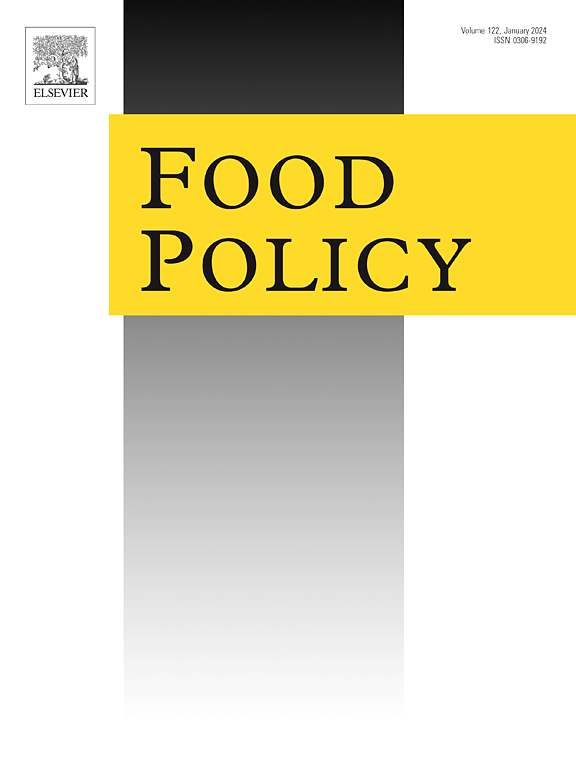Can differentiated value-added tax rates promote healthier diets? The case of Costa Rica
IF 6
1区 经济学
Q1 AGRICULTURAL ECONOMICS & POLICY
引用次数: 0
Abstract
In February 2023, Costa Rica reformed its basic value-added tax basket on which a reduced rate applies to “guarantee a balanced diet”. This paper assesses ex-ante the impact of the reform on nutrient availability and household spending across income groups. Price elasticities are estimated using pooled National Household Income and Expenditure Survey data and a two-step censored quadratic almost ideal demand system model accounting for price and total expenditure endogeneity. Nutritional information is derived from food composition tables. Food items are grouped by processing level as a proxy to explore differences in own- and cross-price effects between ‘healthier’ and ‘less healthy’ items. The demand for ultra-processed sweet and savoury foods is price-inelastic (−0.74 and −0.81, respectively). Lower-income households’ demand is more price-sensitive. The reform applies a reduced rate to a significant number of ultra-processed savoury food items and is associated with an increase in household purchases of calories (0.7%), sugar (0.4%), and saturated fat (1.2%). A counterfactual scenario with a basic tax basket defined based on the Pan American Health Organization nutrient profile model criteria is associated with the largest reductions in calories (−0.2%), sodium (−1.0%), and saturated fat (−0.6%), with higher benefits for lower-income households. It results in minor decreases in household spending (−0.2%). While an increasing number of countries contemplate the taxation of foods high in fat, salt, or sugar, Costa Rica is unique in mandating the consideration of nutritional aspects in determining value-added tax rates. However, the recently adopted basic tax basket may not fulfil this potential.
差别的增值税税率能促进更健康的饮食吗?哥斯达黎加的例子
2023年2月,哥斯达黎加改革了其基本增值税篮子,降低了税率,以“保证均衡饮食”。本文评估了改革对不同收入群体的营养供应和家庭支出的事前影响。价格弹性是使用汇总的全国家庭收入和支出调查数据和一个考虑价格和总支出内生性的两步审查二次几乎理想需求系统模型来估计的。营养信息来源于食物成分表。食品项目按加工水平分组作为代理,以探索在“健康”和“不健康”的项目之间的自身和交叉价格效应的差异。对超加工甜食和咸味食品的需求不具有价格弹性(分别为- 0.74和- 0.81)。低收入家庭的需求对价格更为敏感。这项改革降低了大量超加工咸味食品的税率,并与家庭购买卡路里(0.7%)、糖(0.4%)和饱和脂肪(1.2%)的增加有关。根据泛美卫生组织营养概况模型标准定义的基本税收篮子的反事实情景与最大限度地减少卡路里(- 0.2%)、钠(- 1.0%)和饱和脂肪(- 0.6%)相关,对低收入家庭有更高的好处。它导致家庭支出小幅下降(- 0.2%)。虽然越来越多的国家考虑对高脂肪、高盐或高糖食品征税,但哥斯达黎加是唯一要求在确定增值税率时考虑营养方面的国家。然而,最近采用的基本税收篮子可能无法发挥这一潜力。
本文章由计算机程序翻译,如有差异,请以英文原文为准。
求助全文
约1分钟内获得全文
求助全文
来源期刊

Food Policy
管理科学-农业经济与政策
CiteScore
11.40
自引率
4.60%
发文量
128
审稿时长
62 days
期刊介绍:
Food Policy is a multidisciplinary journal publishing original research and novel evidence on issues in the formulation, implementation, and evaluation of policies for the food sector in developing, transition, and advanced economies.
Our main focus is on the economic and social aspect of food policy, and we prioritize empirical studies informing international food policy debates. Provided that articles make a clear and explicit contribution to food policy debates of international interest, we consider papers from any of the social sciences. Papers from other disciplines (e.g., law) will be considered only if they provide a key policy contribution, and are written in a style which is accessible to a social science readership.
 求助内容:
求助内容: 应助结果提醒方式:
应助结果提醒方式:


